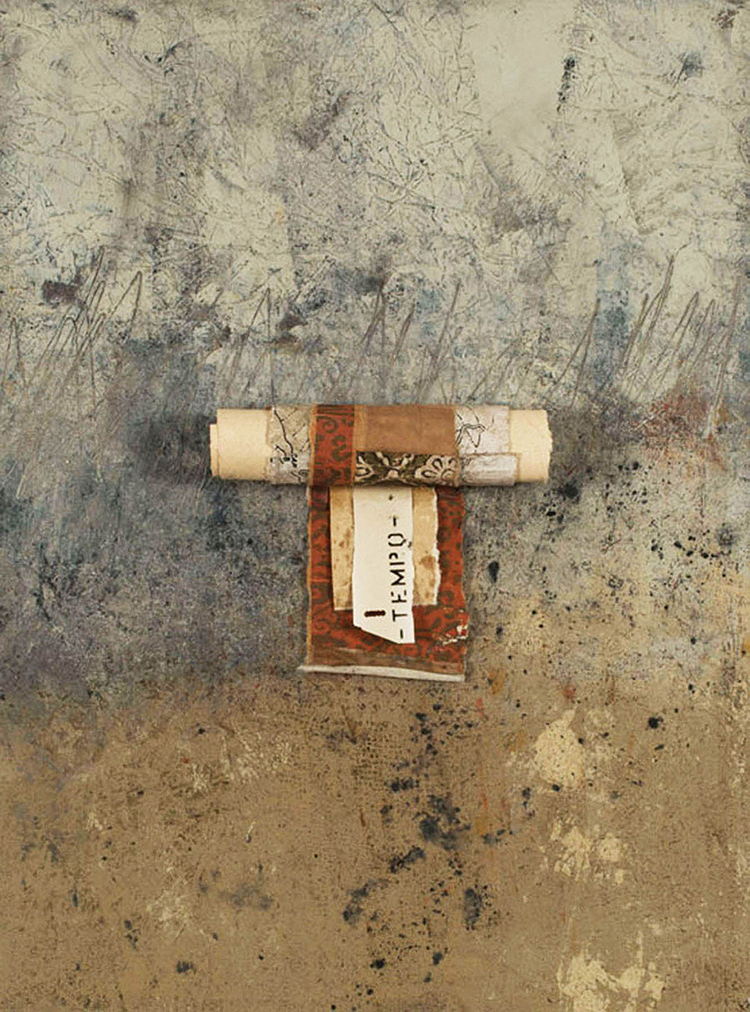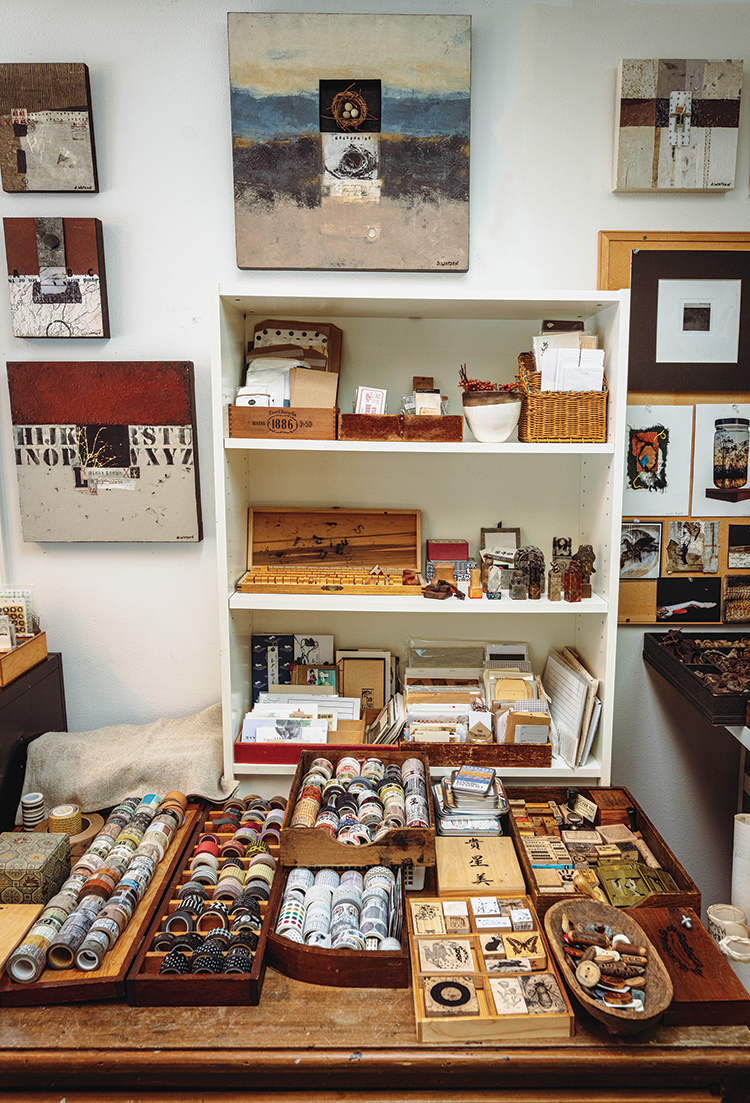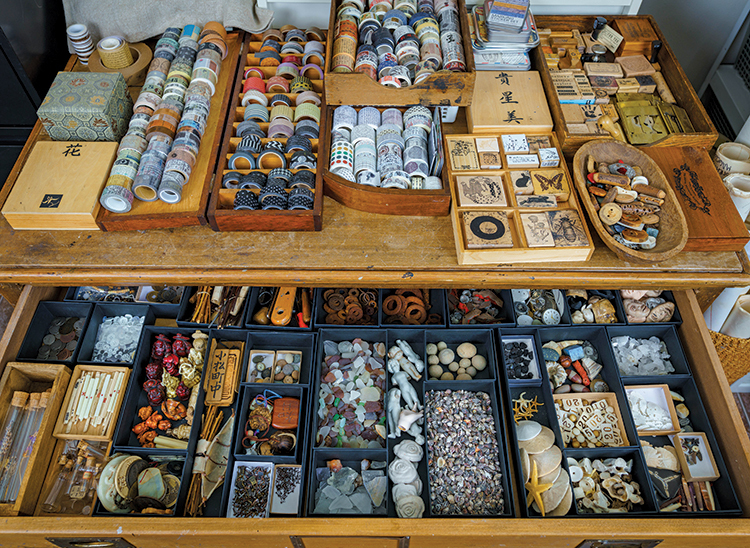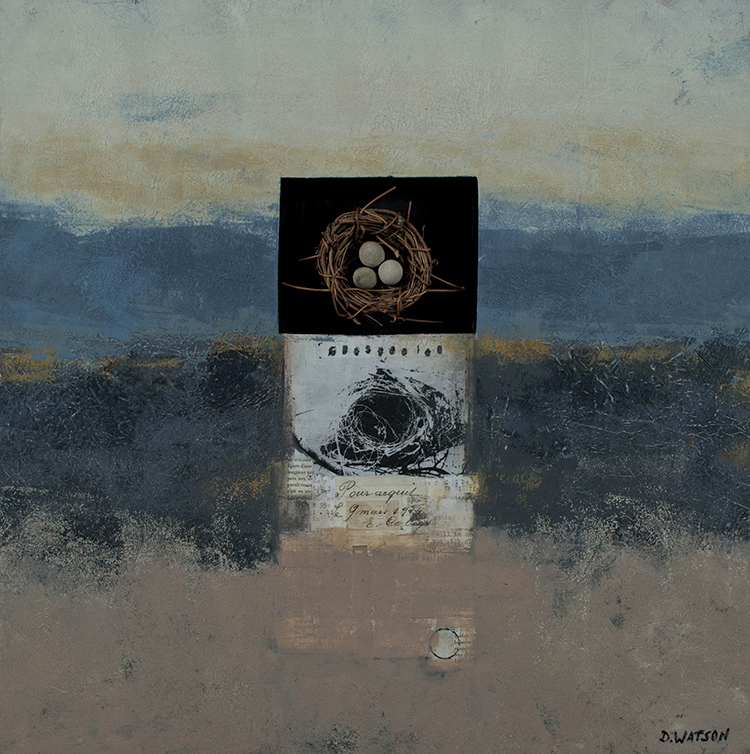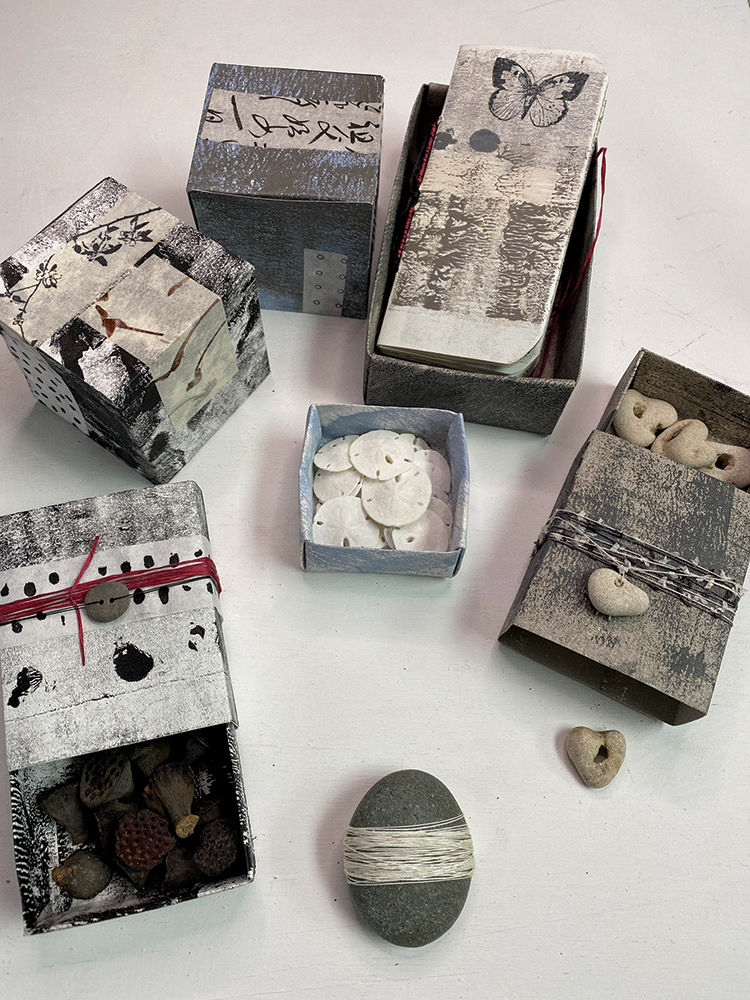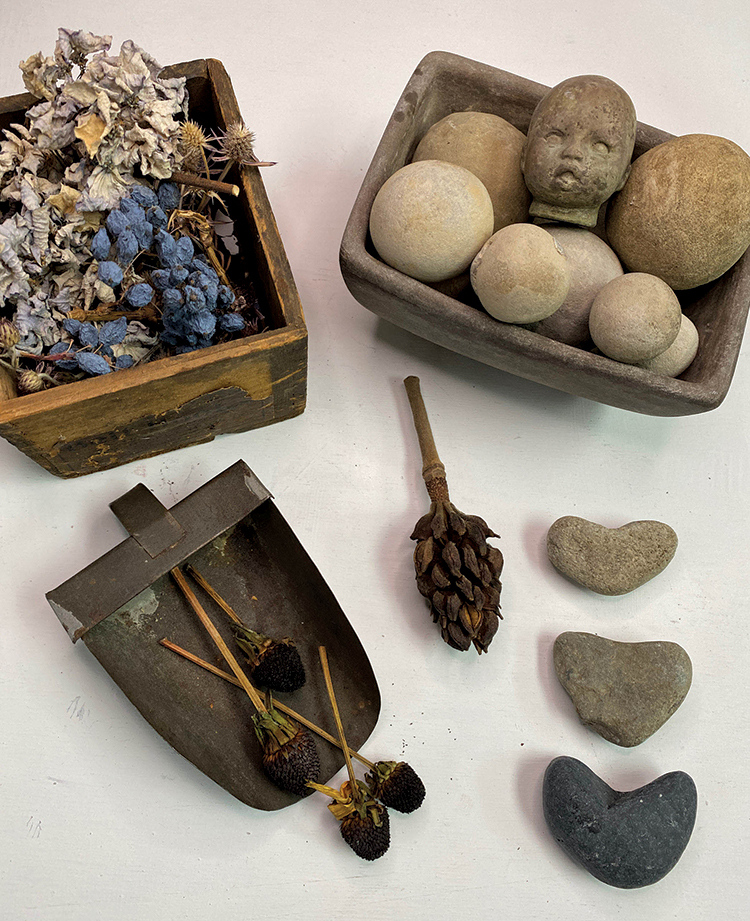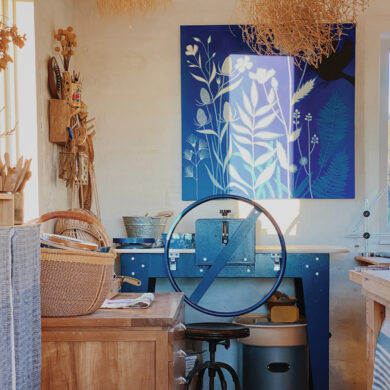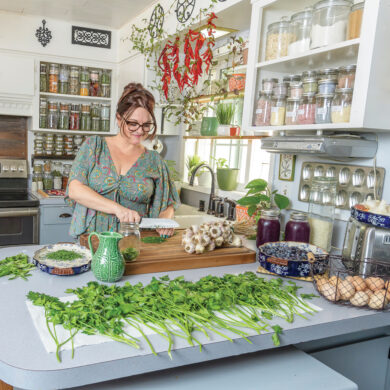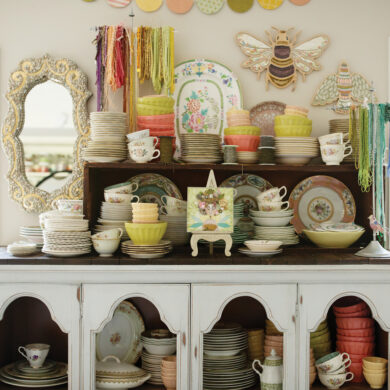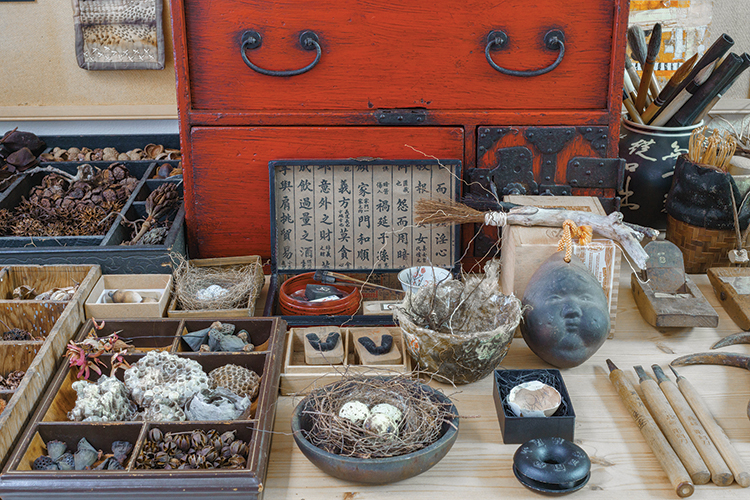
I don’t believe, as an artist, I can separate myself from my art. The way I walk, talk, what colors and clothes I choose to wear, who I choose as friends, my collections, my home décor … all my choices give me away.
Everything is my self-portrait, everything is my diary. My studio is definitely a self-portrait of who I am. Once these choices were unconscious, buried deep inside myself. I believe that an artist should always be on a search to find out their own voice and bring all their choices to a more conscious level. This artistic journey has no ending in sight and is ongoing. The artist will begin where they are at that moment and continue on this journey to discover for the first time who they were all along. It is like going on a trip, and when I return home, I see the same things with new “eyes.”
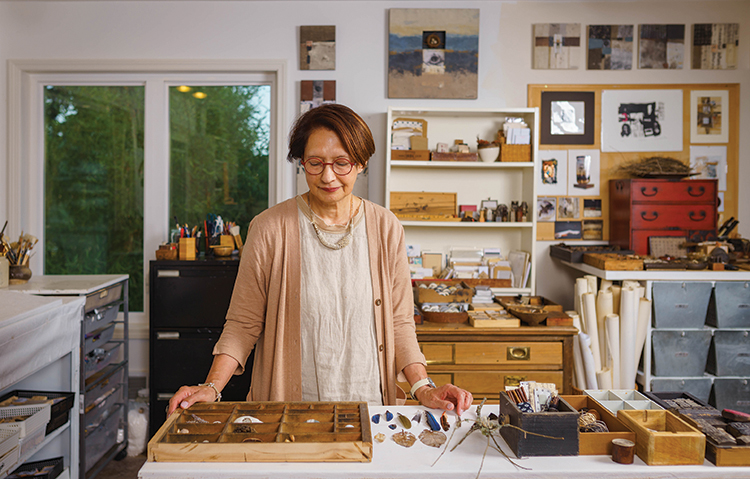
I did not always know who I was or what my unique voice was. Early on in my art journey, I painted pretty landscapes in watercolor. They became very popular and sold very well. I let the money take over, and for a number of years, I completed lots of pretty paintings for the sales. I never gave any thought to the colors I chose or why I chose white houses to paint, just the money. Eventually, I realized I had sold my soul to the devil and had not grown as an artist. I was not expressing any personal meaning in these paintings. I quit painting for a year, falling into a deep dark hole … with no glimmer of light or a way out.
I like to call my art journey STUMBLING TOWARDS THE LIGHT because I did not take the easy detour in the road. I chose the hard bumps, pot holes, and driving in the dark. I finally emerged from this dark place and started a new journey of discovery. I realized I could only create out of my own dark place, not someone else’s dark place. I started to search for myself, who I was, what I liked, what I did not like … my strengths. I made lists and brainstormed words about myself.
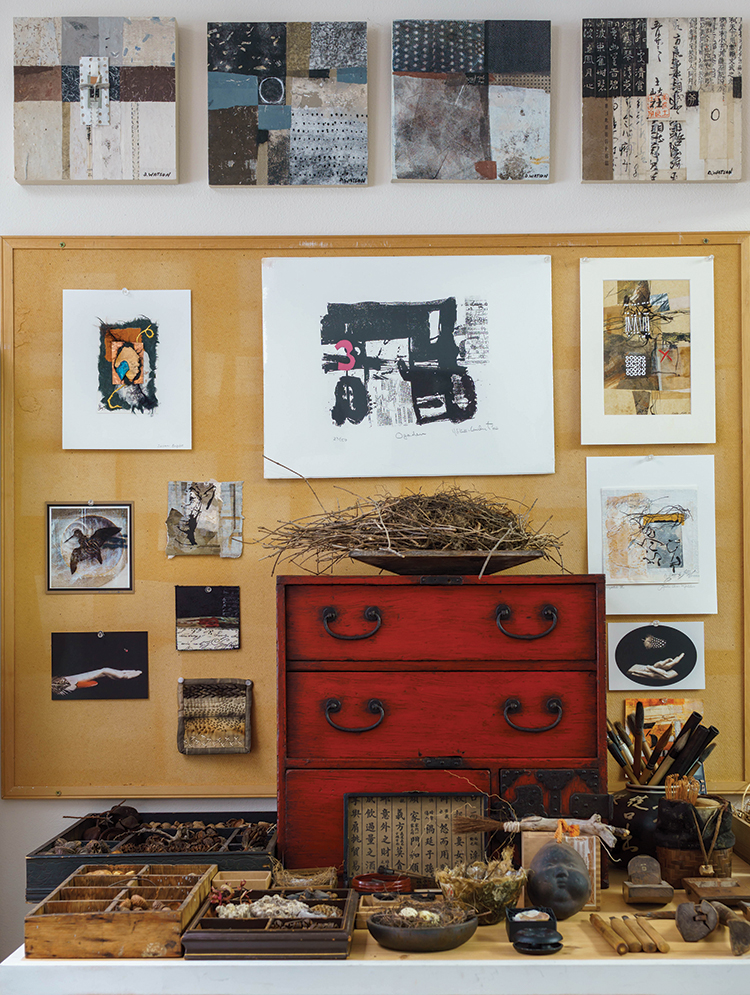
My family heritage is Japanese, and I started to explore and read about Japanese culture and art. I found out about my own family history … my ancestors and their lives. I have been to Japan three times now, and with each trip, I discovered more about myself. I learned that I was more Japanese than I previously knew. I discovered that even those early watercolor paintings had some Japanese design elements … that I did not like much color, and I loved black and white contrast and textures, balance, harmony, and simplicity. I slowly discovered who I was all along, but at a more conscious level. I found a new, solid ground to work from … a different way to work that had more meaning for me, a unique voice that became more clear and conscious. I became who I always was.
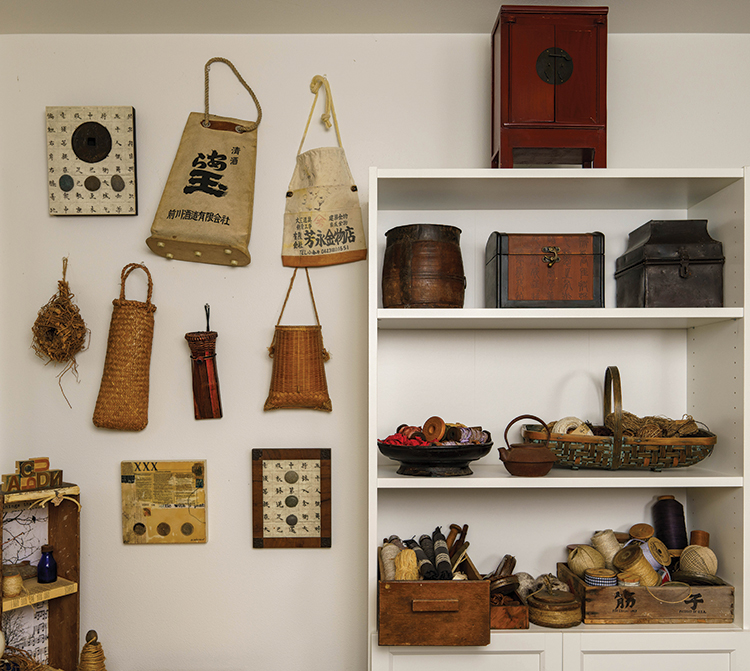
My painting medium changed to acrylic paintings, and I began working on series that had personal meaning to me. I started to add collage, and eventually, I became a collage artist, separate from my paintings. My studio and home became more Japanese, with subdued colors and textures. Every time I came home from Japan, I brought more Japanese decor into my home. I discovered Japanese temple flea markets in Kyoto and brought home old books, envelopes, scrolls, letters, postcards, which I added to my stash of collage papers. I experimented with and discovered a unique way to hand paint Japanese washi papers, which have become a staple in my collages.
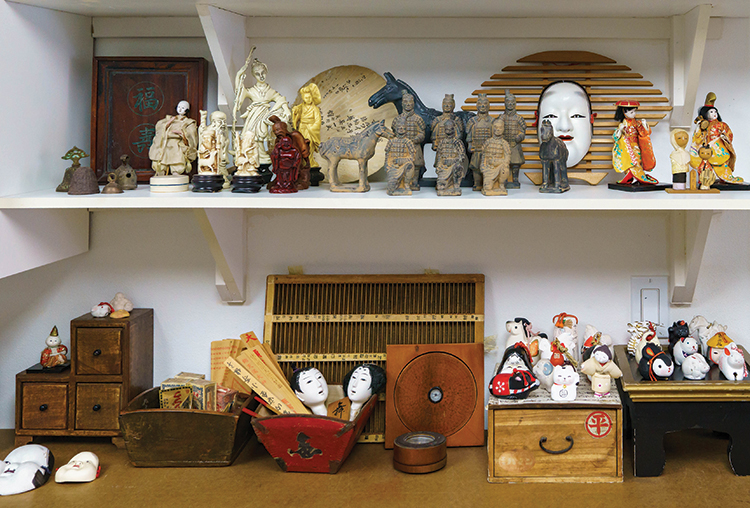
Another major detour on my artistic journey happened about 20 years ago.
We moved to our current home on a cliff on an island in the Pacific Northwest. I filled my home with Japanese furnishings and decor. Outside, we started adding Japanese gardens with water features and miniature stone temples, including a koi pond, moss garden, and a green house.
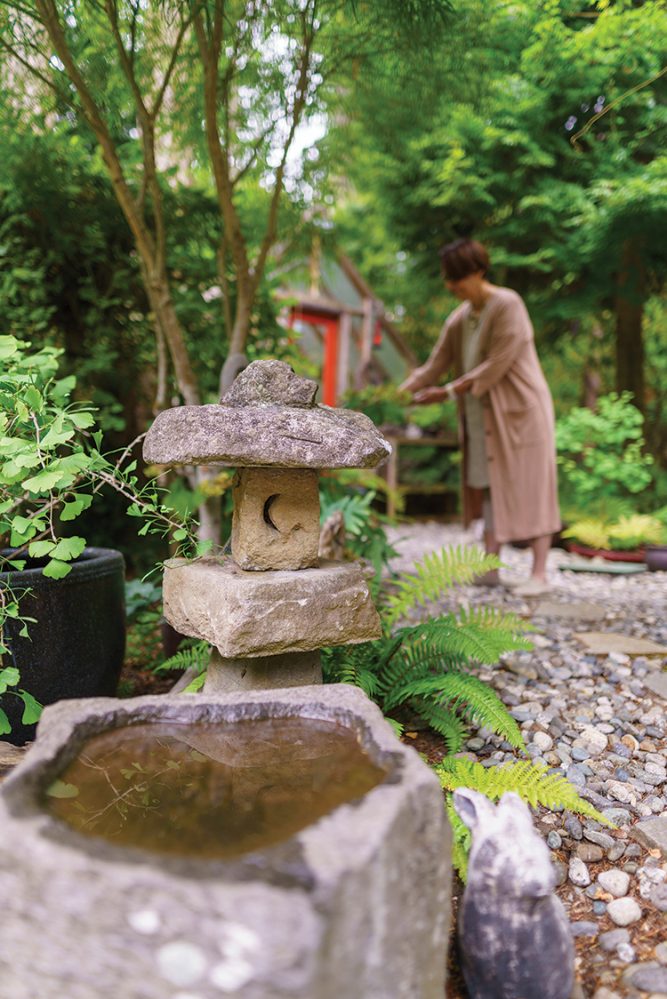
There are woods around my home with trails down to the beach below my home. Every time we go for a walk through the woods down to the beach, I pick up a stick or some moss or lichen. I look down on the trails at all the textures. I look up at the sunlight flickering through the leaves. The Japanese call this “forest bathing,” or being nourished by nature. On the beach, I look for interesting driftwood or a smooth round rock. I began to fill up my studio with all these nature finds. I became a hunter, gatherer, and collector of nature’s offerings. All these collections now mingle and share space in my studio with my Japanese collections of temple bells, dolls, and wooden boxes. My studio became my nature sanctuary filled with rocks, shells, animal bones, fossils, leaves, and seed pods. I have been a collector all my life. When I open a box filled with fragments of stone, stick, shell, moss … traces … findings … I feel a connection to the place I found it. Feelings of gentleness, peace, oneness, belonging, and connection wash over me.
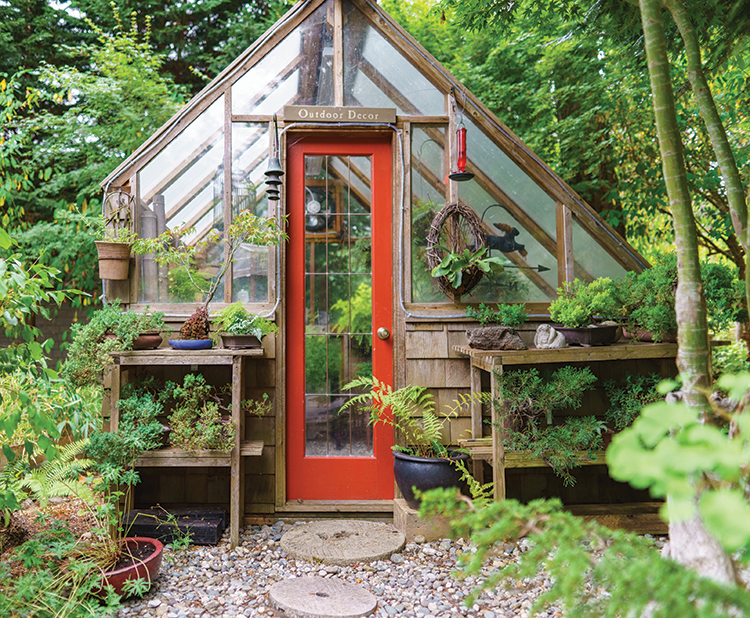
My studio is my refuge and my safe place. I believe artists need a place to go where they feel comfort and safety. Artists should furnish this space with things they love, collect, and cherish. Artists should want to go to this place and stay there … whether they get any work done or not. My studio is filled with all my collections, and when I walk in, I feel at home. My soul comes to peace, and I am able to shut out all the negative news in the world. The Japanese call this the Beauty of Nothingness. Nothingness does not mean empty or void. Nothingness means there is room for new potential for creativity. When I look around my studio, I see inspiration everywhere. I feel like the small tokens and fragments of nature connect me to the outside. I think about the passage of time, the fragile transience of nature, the things that go unnoticed and the ever-changing cycle of life and decay. This acceptance of things being incomplete, impermanent, and imperfect is a Japanese tenet called Wabi Sabi, which I’m attracted to.
These are themes that show up in all my art works.
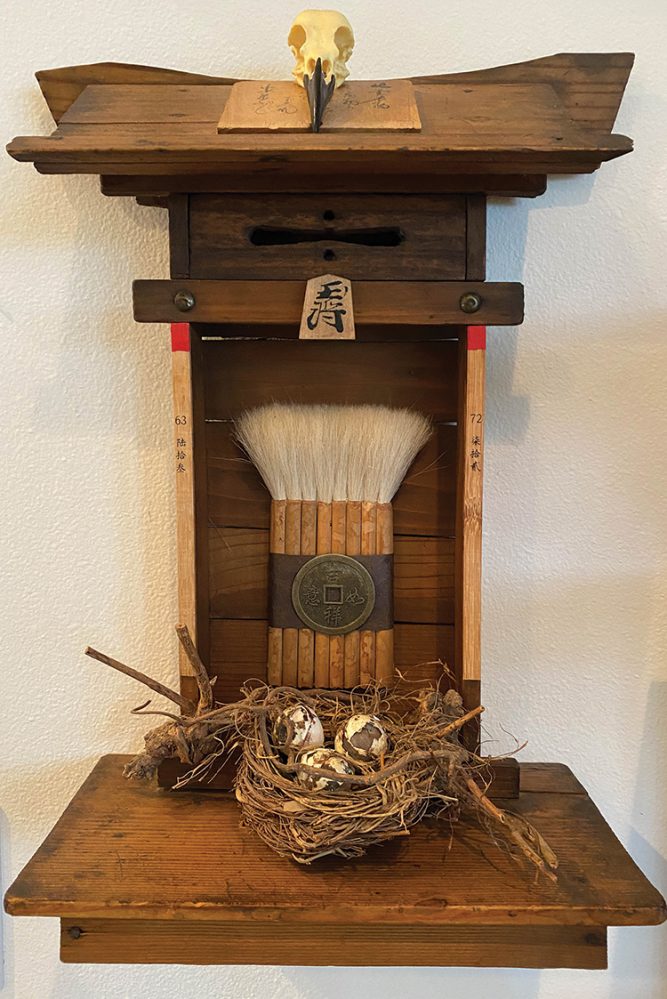
“In the end, she became more than she expected. She became the journey, and like all journeys, she did not end, she just simply changed directions and kept going.”—R.M. Drake (Robert M. Drake)
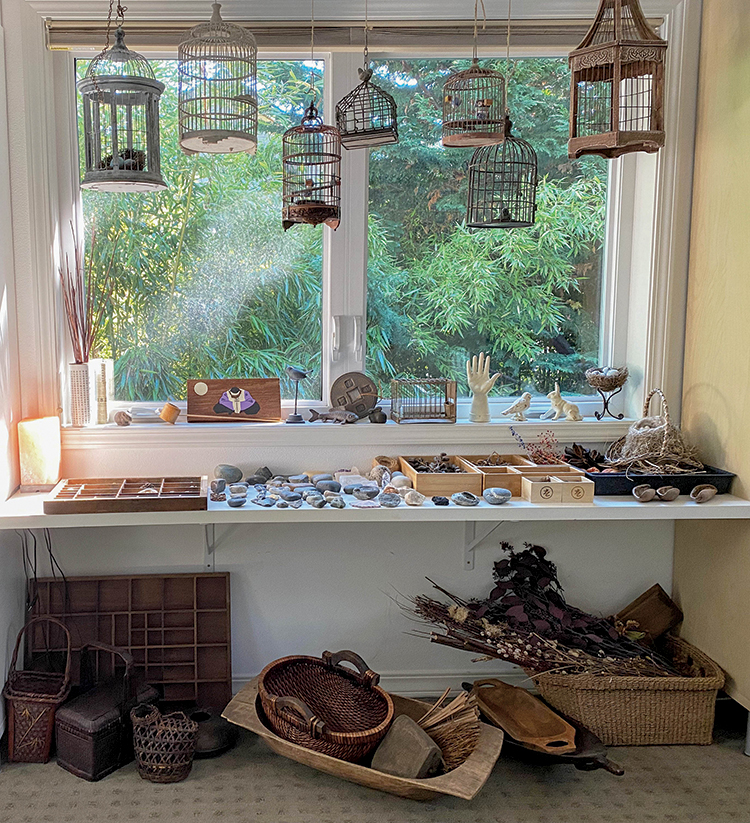
My artistic journey began to expand from painting (I recently changed my medium to cold wax and oil paints) and collage to assemblage. With my assemblage, I began to combine my Japanese influences with nature … wrapping a twig or a rock … and using Japanese papers to showcase things from nature. I am drawn to scrolls and wrapped bundles of paper. I collect strings and chords from Japan and have added these scrolls and paper bundles to paintings, collages, and assemblage. I see some mystery in these scrolls and bundles, a secret message between myself and the viewer. I am fascinated with memories we all have from our childhood, from our own experiences, from our travels, and the people we meet. I believe there is a human connection because we all have memories—not the same ones but similar in ways that make us all human.
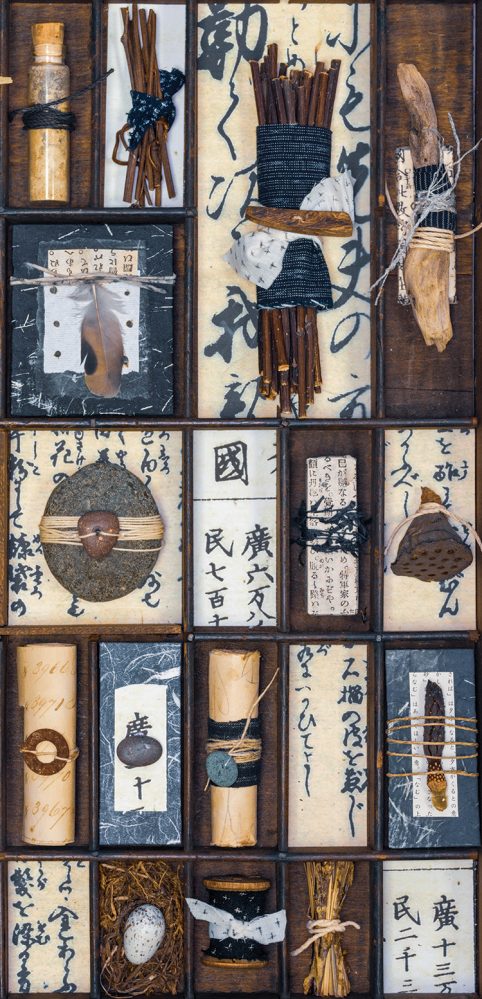
More recently, during the pandemic, when I stayed home and in my studio, I began to make books. Each book would have a Japanese title and a translation, and then I would look for subject matter to express the Japanese word. One book, Yugen, translates to “wonders of nature,” and I used trees as the subject matter. Another book title is Shizuka, which means “peace and silence,” and I used images of the stones I collected from the beach below my home as the subject matter. I titled a book Kintsugi, which means “renewal,” and used my collection of seed pods to represent this rebirth in nature. These books are one way in which I meld my Japanese heritage and aesthetic with my love and connection to nature.
I also like to make small folded boxes and accordion books. The purpose of making these boxes and books is to showcase my nature collections. I like to fold papers—origami-style—into boxes and books and then wrap them with my collection of Japanese strings. This folding and wrapping part of my work fits into my Japanese aesthetic, along with my love of textures, contrast or subdued colors, and mark making.
Art is about a heightened state of awareness. Be alert to the senses. I try to treat everyday life as I would a work of art. I try to create something artful out of something mundane or ordinary; things that are weathered, worn, rusty, old, torn—decayed leaves on the trail or broken driftwood from the beach—can become part of my art work. I see beauty in the small details.
I started my journey in the dark. As I stumbled towards the light, I became more conscious of my inner world, my deeper self, my true core. I created my studio to be my sanctuary, my place to express myself in my own voice to others I want to connect to. My home, gardens, and studio are filled with ME … what I love, what I want to surround myself with and immerse myself in. My studio shouts in a very loud voice who I am to the world.
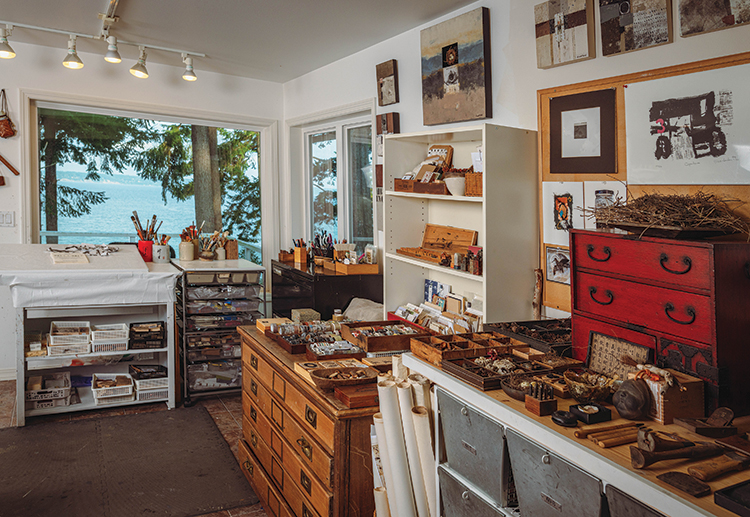

I don’t believe, as an artist, I can separate myself from my art. The way I walk, talk, what colors and clothes I choose to wear, who I choose as friends, my collections, my home décor … all my choices give me away.
Everything is my self-portrait, everything is my diary. My studio is definitely a self-portrait of who I am. Once these choices were unconscious, buried deep inside myself. I believe that an artist should always be on a search to find out their own voice and bring all their choices to a more conscious level. This artistic journey has no ending in sight and is ongoing. The artist will begin where they are at that moment and continue on this journey to discover for the first time who they were all along. It is like going on a trip, and when I return home, I see the same things with new “eyes.”

I did not always know who I was or what my unique voice was. Early on in my art journey, I painted pretty landscapes in watercolor. They became very popular and sold very well. I let the money take over, and for a number of years, I completed lots of pretty paintings for the sales. I never gave any thought to the colors I chose or why I chose white houses to paint, just the money. Eventually, I realized I had sold my soul to the devil and had not grown as an artist. I was not expressing any personal meaning in these paintings. I quit painting for a year, falling into a deep dark hole … with no glimmer of light or a way out.
I like to call my art journey STUMBLING TOWARDS THE LIGHT because I did not take the easy detour in the road. I chose the hard bumps, pot holes, and driving in the dark. I finally emerged from this dark place and started a new journey of discovery. I realized I could only create out of my own dark place, not someone else’s dark place. I started to search for myself, who I was, what I liked, what I did not like … my strengths. I made lists and brainstormed words about myself.

My family heritage is Japanese, and I started to explore and read about Japanese culture and art. I found out about my own family history … my ancestors and their lives. I have been to Japan three times now, and with each trip, I discovered more about myself. I learned that I was more Japanese than I previously knew. I discovered that even those early watercolor paintings had some Japanese design elements … that I did not like much color, and I loved black and white contrast and textures, balance, harmony, and simplicity. I slowly discovered who I was all along, but at a more conscious level. I found a new, solid ground to work from … a different way to work that had more meaning for me, a unique voice that became more clear and conscious. I became who I always was.

My painting medium changed to acrylic paintings, and I began working on series that had personal meaning to me. I started to add collage, and eventually, I became a collage artist, separate from my paintings. My studio and home became more Japanese, with subdued colors and textures. Every time I came home from Japan, I brought more Japanese decor into my home. I discovered Japanese temple flea markets in Kyoto and brought home old books, envelopes, scrolls, letters, postcards, which I added to my stash of collage papers. I experimented with and discovered a unique way to hand paint Japanese washi papers, which have become a staple in my collages.

Another major detour on my artistic journey happened about 20 years ago.
We moved to our current home on a cliff on an island in the Pacific Northwest. I filled my home with Japanese furnishings and decor. Outside, we started adding Japanese gardens with water features and miniature stone temples, including a koi pond, moss garden, and a green house.

There are woods around my home with trails down to the beach below my home. Every time we go for a walk through the woods down to the beach, I pick up a stick or some moss or lichen. I look down on the trails at all the textures. I look up at the sunlight flickering through the leaves. The Japanese call this “forest bathing,” or being nourished by nature. On the beach, I look for interesting driftwood or a smooth round rock. I began to fill up my studio with all these nature finds. I became a hunter, gatherer, and collector of nature’s offerings. All these collections now mingle and share space in my studio with my Japanese collections of temple bells, dolls, and wooden boxes. My studio became my nature sanctuary filled with rocks, shells, animal bones, fossils, leaves, and seed pods. I have been a collector all my life. When I open a box filled with fragments of stone, stick, shell, moss … traces … findings … I feel a connection to the place I found it. Feelings of gentleness, peace, oneness, belonging, and connection wash over me.

My studio is my refuge and my safe place. I believe artists need a place to go where they feel comfort and safety. Artists should furnish this space with things they love, collect, and cherish. Artists should want to go to this place and stay there … whether they get any work done or not. My studio is filled with all my collections, and when I walk in, I feel at home. My soul comes to peace, and I am able to shut out all the negative news in the world. The Japanese call this the Beauty of Nothingness. Nothingness does not mean empty or void. Nothingness means there is room for new potential for creativity. When I look around my studio, I see inspiration everywhere. I feel like the small tokens and fragments of nature connect me to the outside. I think about the passage of time, the fragile transience of nature, the things that go unnoticed and the ever-changing cycle of life and decay. This acceptance of things being incomplete, impermanent, and imperfect is a Japanese tenet called Wabi Sabi, which I’m attracted to.
These are themes that show up in all my art works.

“In the end, she became more than she expected. She became the journey, and like all journeys, she did not end, she just simply changed directions and kept going.”—R.M. Drake (Robert M. Drake)

My artistic journey began to expand from painting (I recently changed my medium to cold wax and oil paints) and collage to assemblage. With my assemblage, I began to combine my Japanese influences with nature … wrapping a twig or a rock … and using Japanese papers to showcase things from nature. I am drawn to scrolls and wrapped bundles of paper. I collect strings and chords from Japan and have added these scrolls and paper bundles to paintings, collages, and assemblage. I see some mystery in these scrolls and bundles, a secret message between myself and the viewer. I am fascinated with memories we all have from our childhood, from our own experiences, from our travels, and the people we meet. I believe there is a human connection because we all have memories—not the same ones but similar in ways that make us all human.

More recently, during the pandemic, when I stayed home and in my studio, I began to make books. Each book would have a Japanese title and a translation, and then I would look for subject matter to express the Japanese word. One book, Yugen, translates to “wonders of nature,” and I used trees as the subject matter. Another book title is Shizuka, which means “peace and silence,” and I used images of the stones I collected from the beach below my home as the subject matter. I titled a book Kintsugi, which means “renewal,” and used my collection of seed pods to represent this rebirth in nature. These books are one way in which I meld my Japanese heritage and aesthetic with my love and connection to nature.
I also like to make small folded boxes and accordion books. The purpose of making these boxes and books is to showcase my nature collections. I like to fold papers—origami-style—into boxes and books and then wrap them with my collection of Japanese strings. This folding and wrapping part of my work fits into my Japanese aesthetic, along with my love of textures, contrast or subdued colors, and mark making.
Art is about a heightened state of awareness. Be alert to the senses. I try to treat everyday life as I would a work of art. I try to create something artful out of something mundane or ordinary; things that are weathered, worn, rusty, old, torn—decayed leaves on the trail or broken driftwood from the beach—can become part of my art work. I see beauty in the small details.
I started my journey in the dark. As I stumbled towards the light, I became more conscious of my inner world, my deeper self, my true core. I created my studio to be my sanctuary, my place to express myself in my own voice to others I want to connect to. My home, gardens, and studio are filled with ME … what I love, what I want to surround myself with and immerse myself in. My studio shouts in a very loud voice who I am to the world.













